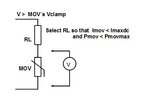Follow along with the video below to see how to install our site as a web app on your home screen.
Note: This feature may not be available in some browsers.



To test a MOV, apply a high voltage with a current limiting resistor in series (1M ohm?). The MOV should conduct and you them measure the voltage across it. Checking the actual voltage with the spec. voltage should indicate as to its possible use.
Frank
most mains MOVs break over at around 390V, because thats just above the peak of 265VAC mains.
you may be wondering where to get that kind of high voltage.......but you can get it from a voltage doubler rectifier on the mains...........it will be too high so just use a pot divider to get your required voltage.



Metal Oxide Varistor (MOV)
Varistor current-voltage characteristics for zinc oxide (ZnO) and silicon carbide (SiC) devices
http://upload.wikimedia.org/wikiped...ien.gif/220px-Typische_Varistorkennlinien.gif
Example datasheet...............
http://www.ibselectronics.com/ibs/cmpnts/rgaco/catalog/D/MetalOVD2_16-opt.pdf
Connect MOV and resistor in series
Select resistor so that dissipated power do not exceed Rated Wattage value given in MOV´s datasheet
varistor DC current is normally 1.0mA or lower. (check datasheet)
Connect voltage higher than MOV´s Clamping Voltage to R and MOV series circuit.
Measure voltage across MOV
Test circuit
View attachment 62725


Hope this gives answer................
View attachment 62759
V/I characteristics for MOV`s 115...750V
View attachment 62761

Is there any difference (in testing procedure) between MOV (Metal Oxide Varistor) or a Varistor ?
DO MOVs used only for AC input supplies ? so, do the normal Varistors ?

Test procedure is same for both.
Both can be used many different circuits (DC and AC ) to absorb transients. ( Usually supply- and power circuits)


MOVs and varistors are bipolar components
ie they can be used both AC- and DC circuits.

Hope this gives answer................
View attachment 62759
V/I characteristics for MOV`s 115...750V
View attachment 62761